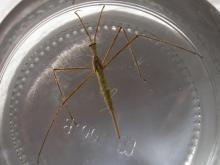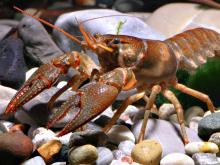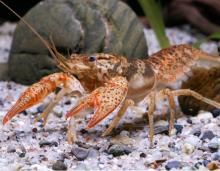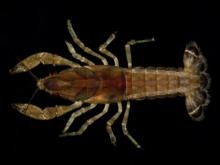Aquatic Invertebrates
Media

Species Types
Scientific Name
Corydalus cornutus
Description
Hellgrammites are the aquatic larval form of eastern dobsonflies. They are fiercely predaceous and look a little like centipedes. Anglers often use them as bait.
Media

Species Types
Scientific Name
Ranatra spp. and Nepa apiculata
Description
Water scorpions remain still, looking like a random bit of plant material. Then they suddenly grab their prey and deliver disabling fluids with a quick jab of their knifelike beak.
Media

Species Types
Scientific Name
Dugesia, Planaria, and other genera
Description
Unlike their parasitic cousins in the flatworm group, turbellarians, or planarians, are tiny carnivores or detritus-eaters that glide smoothly across submerged leaves and other objects.
Media

Species Types
Scientific Name
Faxonius quadruncus (formerly Orconectes quadruncus)
Description
The St. Francis River crayfish is rather small and dark brown, with blackish blotches or specks over the upper surfaces of the pincers, carapace, and abdomen. It is limited to the St. Francis River and its tributaries.
Media

Species Types
Scientific Name
Faxonius hylas (formerly Orconectes hylas)
Description
The woodland crayfish is stout, reddish tan to dark brown, with numerous blackish specks and blotches on the pincers, carapace, and abdomen. It occurs only in Missouri, especially in the Black River and its tributaries.
Media

Species Types
Scientific Name
Faxonius medius (formerly Orconectes medius)
Description
The saddleback crayfish has a bold blackish band across the hind margin of the carapace and lacks dark blotches or specks. The pincers are broad and powerful. It occurs in the Big and Meramec river drainages.
Media

Species Types
Scientific Name
Faxonella clypeata
Description
The shield crayfish is small and tan, with a pattern of paired blackish dashes along the surface of the carapace and abdomen. The pincers are narrow, with short, abruptly tapering fingers. In Missouri it occurs only in our southeast counties.
Media

Species Types
Scientific Name
Various species in the subclass Hirudinea
Description
Most people are repulsed by leeches. But once you get past the fact that many species are parasitic bloodsuckers, you will discover that they are fascinating creatures with an important role in nature.
Media

Species Types
Scientific Name
Freshwater species in the phylum Bryozoa
Description
Bryozoans are tiny, filter-feeding invertebrates. They create colonies that can be mossy, branching, or round and jellylike.
Media

Species Types
Scientific Name
Species in the genera Abedus, Belostoma, and Lethocerus
Description
Giant water bugs are huge aquatic insects that frequently fly around electric lights at night. They are infamous for the painful bite they can deliver, but fish, birds — and some people — find them tasty!
See Also
About Aquatic Invertebrates in Missouri
Missouri's streams, lakes, and other aquatic habitats hold thousands of kinds of invertebrates — worms, freshwater mussels, snails, crayfish, insects, and other animals without backbones. These creatures are vital links in the aquatic food chain, and their presence and numbers tell us a lot about water quality.





















